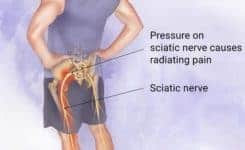What is Sciatica?
Back pain is one of the most common health complaints. It can occur after a person is injured or present with no apparent cause. The pain can be a short-lived event or become a long-term problem. In many cases, back pain can be treated with manual (massage or physical) therapy, stretching and over-the-counter pain relievers, but severe and persistent cases can require surgical procedures and prescription medication. Sciatica pain is a form of back discomfort that is easy to identify and treat.
What is Sciatica?
 This is a condition that develops when a person has a herniated disk in the lower back. Spinal disks become worn from either age or injury, causing a bulging of the soft center that puts pressure on surrounding nerves. The sciatic nerve runs from the lower back through the hips, legs, and feet on both sides of the body. When this nerve is pressured from a herniated disk, the person will experience lower back pain that can radiate into the hips and down the legs.
This is a condition that develops when a person has a herniated disk in the lower back. Spinal disks become worn from either age or injury, causing a bulging of the soft center that puts pressure on surrounding nerves. The sciatic nerve runs from the lower back through the hips, legs, and feet on both sides of the body. When this nerve is pressured from a herniated disk, the person will experience lower back pain that can radiate into the hips and down the legs.
What are the Causes?
Age plays a large role in developing this condition. The majority of cases occur between age 30 and age 50. Those who are overweight and obese have a higher risk of back pain, as do pregnant women and diabetics. A person who works a job that involves a great deal of heavy lifting or extensive sitting all day may also get sciatica. In some cases, the cause can be spinal stenosis or bone spurs.
What are the Signs?
The discomfort begins in the lower back, usually on one side, although both sides can be involved. Sciatica pain may present as a dull ache or a very sharp pain that radiates down the sides or backs of the legs. Other symptoms include numbness, a tingling sensation or a feeling of weakness in both the legs and the feet.

Good blog on sciatica. I have had this problem for years after I got rear ended by another car. It’s been years and massages are the thing that helps me! I love massages! 💖